With the world’s 1.3 billion Catholics now mourning the death of Pope Francis, here is what will happen in the coming days.
News of the 88-year-old’s passing was announced earlier today, two months after he was admitted to hospital with an infection that developed into pneumonia in both lungs and then kidney failure. He spent his final hours blessing thousands of people in St. Peter’s Square on Easter Sunday.
There will now be nine days of official mourning, but the historic process of the conclave – where cardinals will gather in the Sistine Chapel at the Vatican to choose who will be the next pope – will not begin for at least 15 days from today.
The Vatican Chamberlain, currently Cardinal Kevin Farrell, will first certify officially that Francis is dead by calling his name three times at his bedside.
The Pope’s office and private apartments will be sealed and the papal fisherman’s ring removed from his finger and broken with a hammer.
The body of the Pope will then be dressed in red robes with a white mitre on his head, and he will be taken to St Peter’s Basilica, where he will lie in state for three days.
His funeral will take place within six days, and then – in contrast to most of his predecessors – Francis be buried in the basilica of Santa Maria Maggiore in Rome’s Esquilino neighbourhood, rather than in the grottoes beneath St Peter’s.
Only cardinals who are aged 80 and under – so 138 of 252 currently – can vote in the conclave.
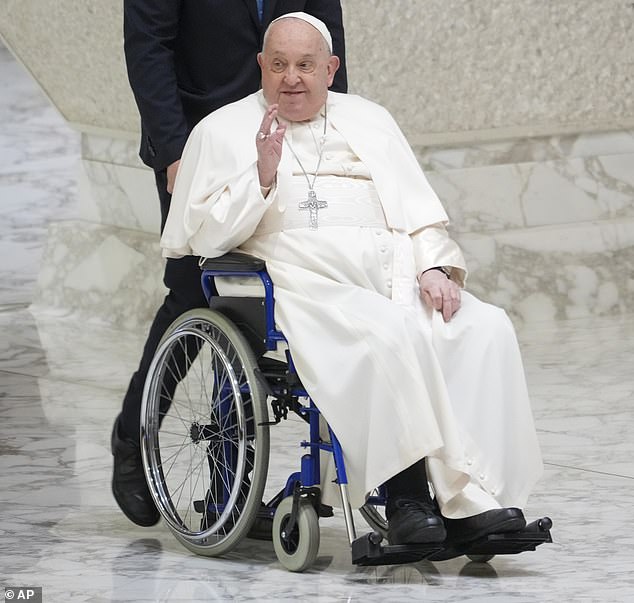
Pope Francis has died aged 88. Above: The Pope using a wheelchair at the Vatican, February 3, 2025
Cardinals will be locked inside the Chapel without access to technology or the outside world until a new pope is chosen by two-thirds majority.
The previous conclave – when Pope Benedict stepped down in 2013 – took just a day, but technically they can last weeks, months or even years.
In modern times, they have tended to only last a few days. If after around two weeks of balloting no new pope has been chosen, cardinals can opt for a majority vote.
The conclave’s first day begins with the ‘Pro eligendo Romano Pontificie’ Mass for the election of a pope.
Cardinals will gather in the afternoon in the Pauline Chapel of the Apostolic Palace and then file into the Sistine Chapel.
As they do so, they will chant the Litany of Saints and the Latin hymn Veni Creator, which implores the saints and the Holy Spirit to help them in their decision.
Standing under Michelangelo’s ‘Creation’ and before his ‘Last Judgment,’ each cardinal places his hand on the Gospels and pledges ‘with the greatest fidelity’ never to reveal the details of the conclave.
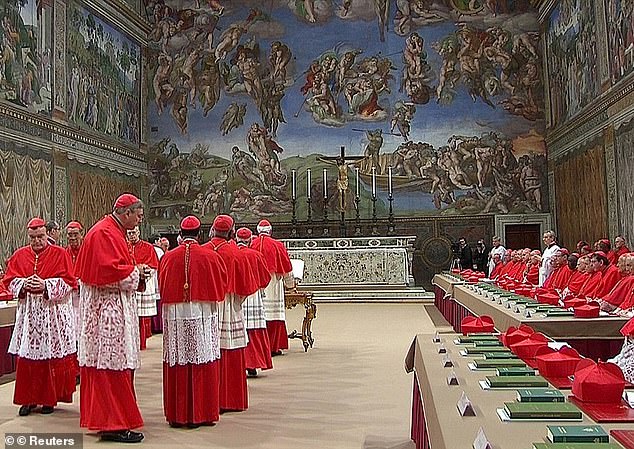
The Conclave will take place in the Sistine Chapel. Above: Cardinals on the first day of the Conclave in 2013, after the resignation of Benedict
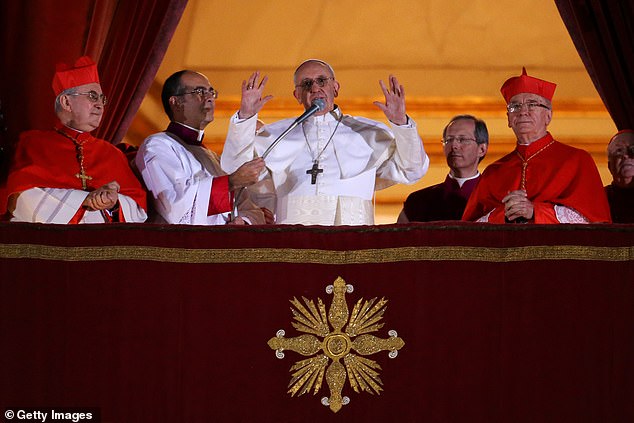
Pope Francis addressing the faithful form the balcony of St Peter’s Basilica after being chosen as the new pontiff, March 13, 2013
A meditation on the qualities needed for the next pope and the challenges ahead for the church is delivered by Maltese Cardinal Prosper Grech.
The master of liturgical celebrations then cries ‘Extra omnes’, Latin for ‘all out.’
Everyone except the cardinals then leaves and the voting can begin.
Each cardinal writes his choice on a piece of paper inscribed with the words ‘Eligo in summen pontificem,’ (I elect as Supreme Pontiff).
One by one, they approach the altar and say: ‘I call as my witness, Christ the Lord who will be my judge, that my vote is given to the one who, before God, I think should be elected.’
The folded ballot is placed on a round plate and slid into an oval silver and gold urn.
In the past, a single chalice was used to hold the ballots.
But conclave changes made by Pope John Paul II in 1996 required three vessels: one for chapel ballots, another for ailing cardinals at the Vatican who can vote from their beds and the third to hold the ballots after counting.
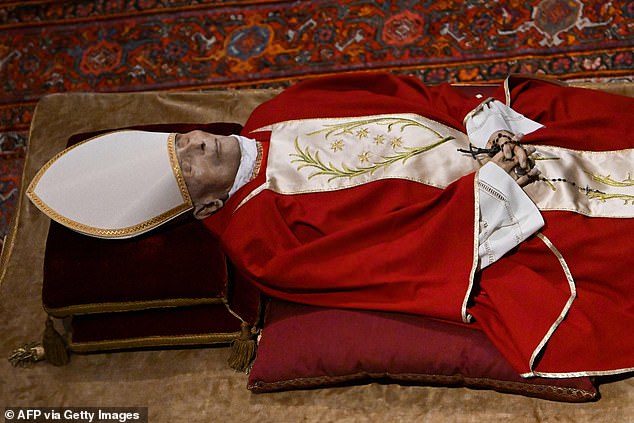
In line with tradition, Benedict lay in state inside St Peter’s Basilica (above, January 2023) and was then buried in a crypt underneath the building. Pope Francis will be buried in the basilica of Santa Maria Maggiore in Rome’s Esquilino neighbourhood
Outside, in St Peter’s Square, tens of thousands of Catholics will be watching – along with millions more on television around the world – to see smoke emerging from the chimney of the Sistine Chapel after each voting round.
Black smoke means no decision has reached, white smoke means a new pope has been selected.
The smoke arises from the burned ballots, and a dye is added to make sure the smoke is the right colour each time.
Once the cardinals have chosen from among their number the master of liturgical ceremonies will enter the Sistine Chapel.
The prospective choice will be asked: ‘Do you accept your canonical election as Supreme Pontiff?’
Assuming they say, ‘I accept’, the cardinal will then be asked by what name they wish to be known.
The new pope will then be given their iconic white cassock, before each cardinal approaches him to swear obedience.
The Pope will then emerge onto the balcony overlooking St Peter’s Square, to address the jubilant faithful for the first time.
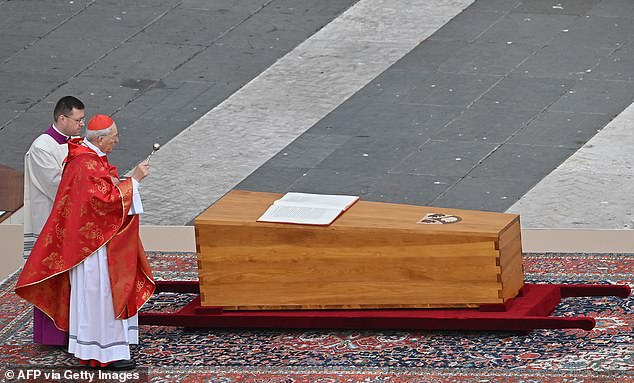
Cardinal Giovanni Battista Re blesses the coffin of Pope Emeritus Benedict XVI during his funeral mass at St. Peter’s square in the Vatican, on January 5, 2023
Preceding him will be Dominique Mamberti, the Cardinal Protodeacon. He will announce ‘Habemus Papam’, the Latin for ‘We have a new pope’.
Francis was first admitted to hospital on Valentine’s Day with breathing difficulties.
The Pope’s chosen place of burial is one of the four major papal basilicas. Seven popes – from Honorious III in 1216 to Clement IX in 1669 – were buried there.
But most, including Francis’s immediate predecessor Pope Benedict, are buried beneath St Peter’s.
Francis revealed his decision to be buried elsewhere in 2023.
In a further break with tradition, new rites issued last year said Francis will be laid to rest in a single zinc-lined wooden casket.
Pope Francis used to pray at the basilica of Santa Maria Maggiore before and after trips overseas.
He made more than 100 visits to the fifth-century church, where he would pray in front of a sacred image of the Virgin Mary and baby Jesus.







